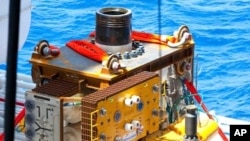Oil giant BP says it is making progress installing a new containment cap over its well that has been spewing oil largely unchecked into the Gulf of Mexico.
BP said Sunday it is lowering a connector onto a leaking pipe that must be bolted into place before a giant object called a capping stack can be mounted.
The company said the new containment system will take four to seven days to install and will allow ships on the surface to capture virtually all the leaking oil.
BP Vice President Kent Wells said his company has tried to work out as many problems as it can to install the new containment cap, but he said challenges remain.
White House adviser David Axelrod told a U.S. television network Sunday that he is confident BP's new containment effort will work. He said he hopes all the oil escaping the well will be contained by the end of July.
BP began the new containment operation Saturday by removing a previous cap that loosely covered the leak. The cap's removal is allowing oil to gush largely unchecked into the Gulf until the new cap is in place.
The spill is the largest ever in U.S. waters. It has fouled huge expanses of the U.S. Gulf coast, wreaked havoc on birds and sea creatures, and devastated U.S. fishing, tourism and other industries.
The administrator of a $20 billion BP fund to help affected Gulf residents said the company is speeding up the processing of damage claims. Ken Feinberg said Sunday BP will offer eligible claimants a payment equal to six months' worth of losses, rather than month-by-month payments.
BP has been drilling two relief wells to permanently plug the leak, but the first well is not expected to be ready until mid-August. The leak began after an explosion destroyed a BP oil rig and killed 11 workers.
U.S. Attorney General Eric Holder said Sunday the Justice Department has started interviewing witnesses as part of a criminal and civil investigation of the oil spill.
Some information for this report was provided by AP, AFP and Reuters.







